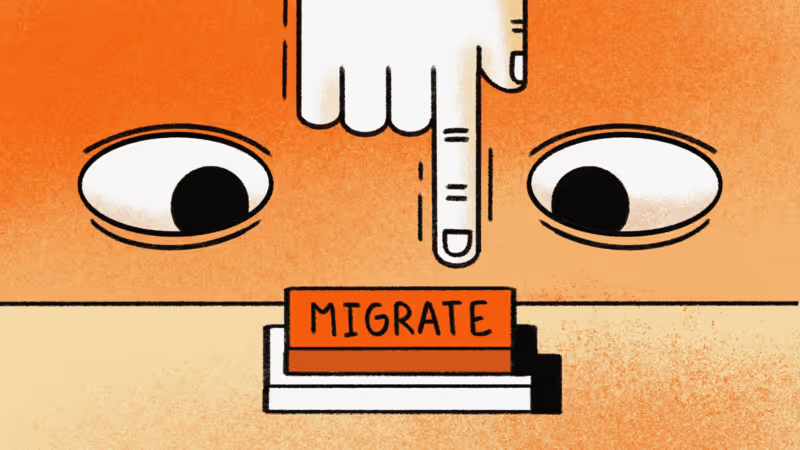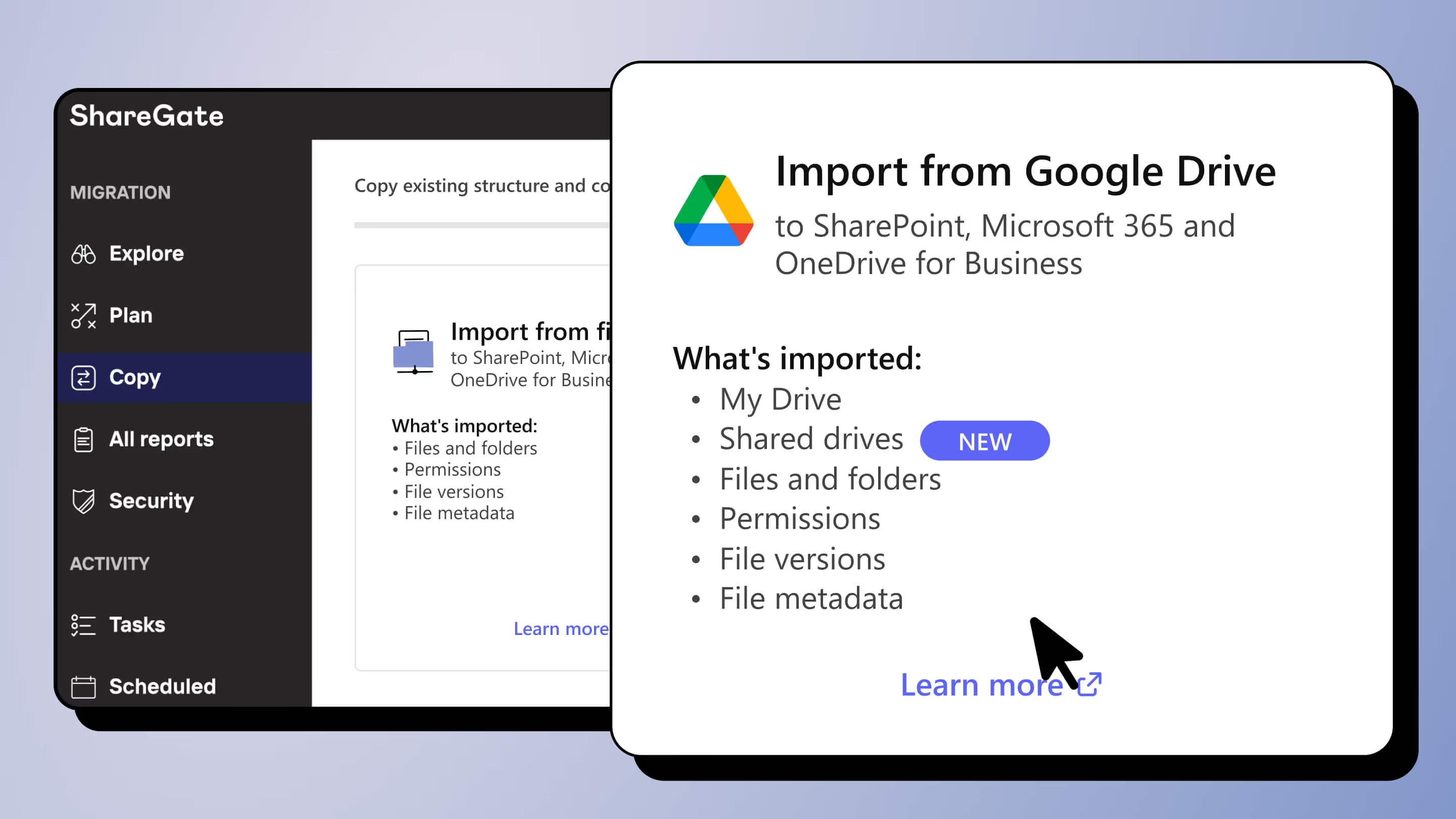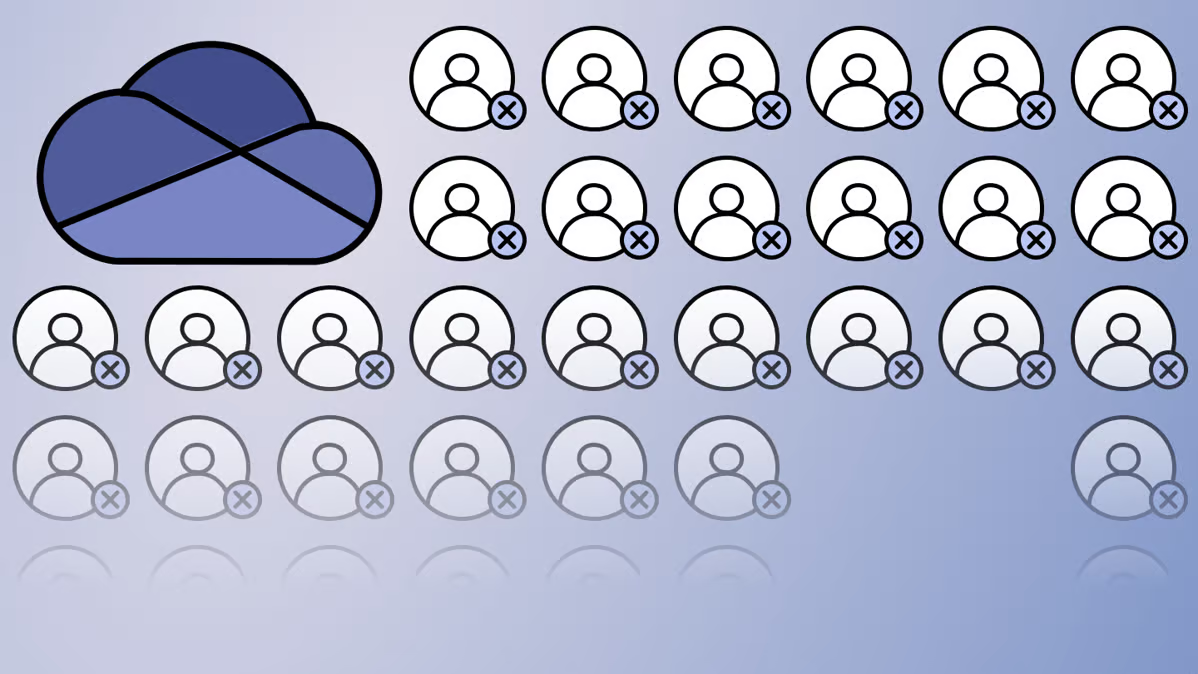Migrate Google Drive to SharePoint and Microsoft 365 with ShareGate

Table of contents
The benefits of moving from Google Drive to SharePoint are numerous—but if you're thinking this kind of migration is a tough nut to crack, think again. Check out some best practices and learn how ShareGate can make this transition smooth and simple.
Migrating from Google Drive to SharePoint can be life-changing for any organization. Shifting from simple file collaboration to the dynamic, robust solution SharePoint provides is a big move, but we at ShareGate believe IT teams shouldn't waste their precious time doing it. SharePoint and Microsoft 365 migration and management should be as smooth and simple as possible—and our job is to make it happen.
In this article, we'll explore how ShareGate makes it easier to migrate your Google Drive files to SharePoint and Microsoft 365. We'll explain why IT admins everywhere are migrating their Google Drive files to Microsoft SharePoint and what you'll need to know if you're thinking about doing that, too. You'll also learn about four best practices to make your migration easier. Let's get going!
Why migrate Google Drive to SharePoint Online
IT admins choose SharePoint Online over Google Drive because of the enhanced document management features SharePoint provides. This includes better version control, metadata tagging, and more customizable permissions, offering superior organizational capabilities and security.
SharePoint Online is also part of the Microsoft 365 suite, which provides a unified environment where end users can access and share files across various Microsoft applications. This ability helps to streamline workflows significantly and enhances productivity at all levels.
Search is easier, too. SharePoint offers powerful search capabilities, so end users can find the files they need faster. Faster and more efficient information retrieval means less wasted time and more productive work. Teams can collaborate seamlessly in SharePoint Online, working together simultaneously to edit their documents in real time.
Another reason IT admins are opting for SharePoint Online is its scalability. SharePoint Online sites easily accommodate increasing file storage needs with the flexibility admins need as their organizational requirements evolve.
Whatever your reasons for migrating your Google Drive files to SharePoint, third-party tools like ShareGate can make that process easier and more secure.
Google Drive to Microsoft 365 migration tools
There are a few different ways to migrate from your Google Workspace to Microsoft 365. These include manually transferring your files, using the Microsoft 365 Migration Manager, or leveraging third-party tools like ShareGate.
Each method has advantages and other things you must consider when choosing how to achieve the smooth and efficient migration every IT admin dreams of.
- Manual migration - While you could manually migrate Google Drive to SharePoint Online, we don't recommend it. The reason is that the amount of work (along with the potential for error) could blow up exponentially—unless you're dealing with a very small-scale, simple migration.
- Microsoft 365 Migration Manager – The Microsoft 365 Migration Manager is a good option, depending on your needs. (Also, it's free.) It supports file migrations—but not folders—and can be used for larger-scale transfers. However, it requires taking quite a few steps to migrate and it has no drag-and-drop functionality. Also, if you make a mistake choosing your destinations, you'll have to close the app and start all over.
- Third-party tool - Several such tools are on the market today, each specializing in migrating data between different cloud platforms. One of the chief advantages of these tools is that, like ShareGate's migration platform, they often offer more advanced features than you can get with Microsoft's SPMT, such as data mapping, security settings migration, and faster data transfer.
What to know when migrating from Google Drive to SharePoint and Microsoft 365 with ShareGate
Whether you're thinking about a full migration from Google Drive to SharePoint Online and Microsoft 365, an incremental migration, or if you've already migrated some files and are planning a delta migration, there are many things you need to consider.
This includes the mechanics of your migration and the challenges you might encounter during the migration process. While ShareGate can help you avoid these challenges, it's a good idea to understand ahead of time where the bumps in the road are so you can navigate them.
Challenges in transitioning from Google Drive to SharePoint Online
One of the biggest migration challenges in a SharePoint Online migration from Google Drive is figuring out how to do it efficiently. This is because elements like permissions, shared links, and embedded links work differently in SharePoint Online and Google Workspace.
For example, your migration will likely involve multiple sites in Google Drive with content to be migrated to various sites in SharePoint Online. Whatever tool you use to perform your migration, it's essential to make sure it gives you the ability to map (ideally, easily) all the different paths from your Google Workspace drives to their proper destinations in SharePoint Online. The more complex your Google Drive is, the more challenging this will be.
Migration from Google Drive with ShareGate 101
As we mentioned before (and as you might already know from experience), ShareGate is the go-to solution if you need to migrate to Microsoft 365 smoothly and seamlessly. Now let’s see a few basics you need to know about what to expect when you move from Google Drive to SharePoint Online:
- The Google Drive migration functionality is readily available in the ShareGate interface as a drag-and-drop process. How easy is that?
- With ShareGate, you can copy over all your Google Drive content to a library so you maintain your folder structure and its contents. However, make sure you have this library identified at the destination to place your content prior to the migration.
- During the migration, all Google files will be converted to their Microsoft equivalent (for example, Docs to Word, Sheets to Excel).
- If you need to migrate content from multiple Google Drives to multiple destinations (for example, migrating each user's Google Drive to their equivalent OneDrive), you can do a sequenced/bulk migration with the ShareGate PowerShell module so you map multiple combinations of sources and destinations to be migrated sequentially.
For more details on the migration process with ShareGate, check out this document.
Managing user access and permissions in SharePoint
Before you transfer Google Drive data, you'll need to define roles and responsibilities for all end-user accounts within SharePoint to ensure they can access Google Docs and other files they need. Depending on the complexity of your organization and the number of files you're dealing with, this can be challenging because you also have to map all the user access permissions correctly.
Once you transfer files, you can use SharePoint groups to manage permissions for specific teams or departments more efficiently. However, it would be best if you still planned on regularly reviewing and auditing user permissions to ensure proper access and security.
Fortunately, SharePoint's built-in permission levels, such as Full Control, Contribute, Read, and Limited Access, work similarly to the permission levels in Google Drive. However, you'll probably still need to train users to understand and request permissions for specific files.
Best practices for a successful Google Workspace to Microsoft SharePoint Online migration
Here at ShareGate, we've helped countless organizations successfully migrate from Google Workspace to SharePoint and have identified four best practices that, together, always make the entire migration process easier:
1. Data governance and cleanup
Migration offers an ideal opportunity for a fresh start. Spending time on the front end to identify what Google files (e.g., Google Docs, Google Sheets, etc.) need to be migrated and what files don't will pay off in some big ways. Eliminating outdated, redundant, and irrelevant files before you begin your migration helps to optimize the process and results in a less cluttered SharePoint environment right from the start.
In addition, taking the time to develop a solid data governance strategy will help you keep your environment more orderly going forward.
2. Third-party integrations and customizations
It's also crucial for your migration team to identify any third-party integrations different teams in your organization might be using on Google Drive to avoid any unanticipated disruptions. Then, you need to evaluate their compatibility with SharePoint.
Some tools may work with some reconfiguration, while others may not be compatible. Neither of these scenarios needs to become a problem if you implement this pre-migration best practice. Doing so will give you time to reconfigure or find suitable alternatives if needed.
The same practice applies to any custom scripts you currently use in Google Drive before migration to help ensure you can achieve the same functionality in SharePoint post-migration.
3. Bandwidth and network considerations
Evaluating your network's capabilities is another pre-migration best practice that will significantly minimize, if not eliminate, the potential for migration disruption. It starts with assessing your organization's available bandwidth to determine the maximum amount of data you can move simultaneously.
Once you know this, you can look at usage patterns further. This allows you to plan your migration around periods of peak demand on your capacity, creating a schedule for transferring data during off-peak times and maintaining operational efficiency during your SharePoint migration.
4. Post-migration follow-up and support
While it would be nice to think your work is done once you migrate Google Drive. However, you'll still have some work to do even after completing your SharePoint migration. Invariably, end users will encounter challenges understanding how to navigate their new SharePoint sites, locate a particular document library, or use one of the new Microsoft 365 apps available to them in their new SharePoint environment.
You can minimize this aspect of your post-migration work by establishing a dedicated post-migration support channel and creating a knowledge base to cover the most common questions you might get from end users. Doing these two things will help reduce end-user frustration and result in far fewer support tickets, saving you much time.
Benefits of migrating from Google Workspace to SharePoint
SharePoint offers many advantages over Google Workspace in terms of its document management and organization capabilities and enhanced security features. This, combined with the best-in-class apps that come with the Microsoft 365 productivity suite, it's no surprise that so many organizations are opting to migrate Google Drive data to SharePoint online.
Still, migrating from Google Drive is not for the faint of heart. The sheer complexity of the task, combined with the risk of disruption to key business activities, is enough to keep even the most experienced IT manager up at night.
Fortunately, with ShareGate as your trusty sidekick, your migration can be smooth and seamless. To explore how ShareGate's migration tool can make you look like an IT superhero (and help you sleep better at night), check out our online migration guide for migrating your data from Google Drive!
.jpg)


.svg)
%20(1).avif)







.png)




.jpg)



